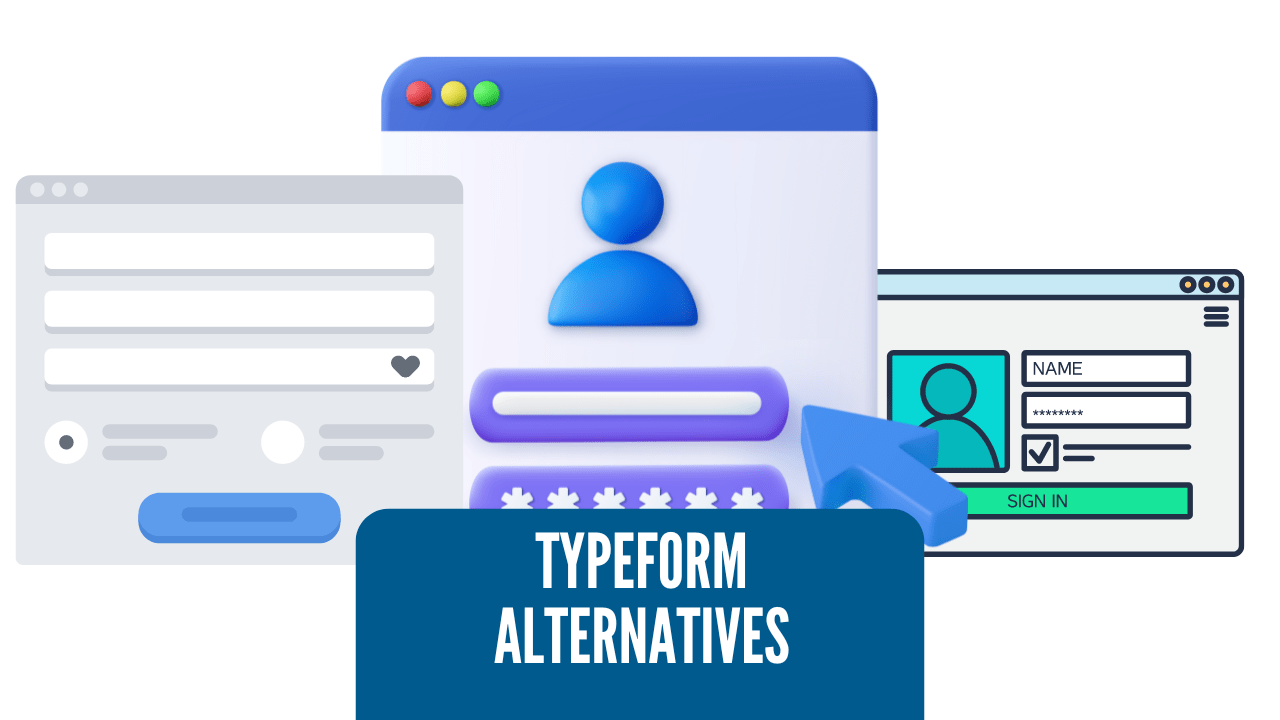If you’ve found this post, you’re probably looking for Typeform alternatives that are cheaper, but just as elegant a solution for lead generation. We’ve put together a list of alternative Typeform options, all more affordable, some are even open source and free.
We looked at cost-effectiveness as well as advanced features such as analytics. Read on for our guide and find out if there’s a solution to suit your form building needs without straining the budget.
Quick Overview of Top Picks for Lead Generation
Here’s a quick rundown of the crème de la crème in the form-building arena:
Each platform brings its own set of superpowers to the table, from budget-friendly basics to high-tech customizability.
Jotform: The All-Rounder for Diverse Industries
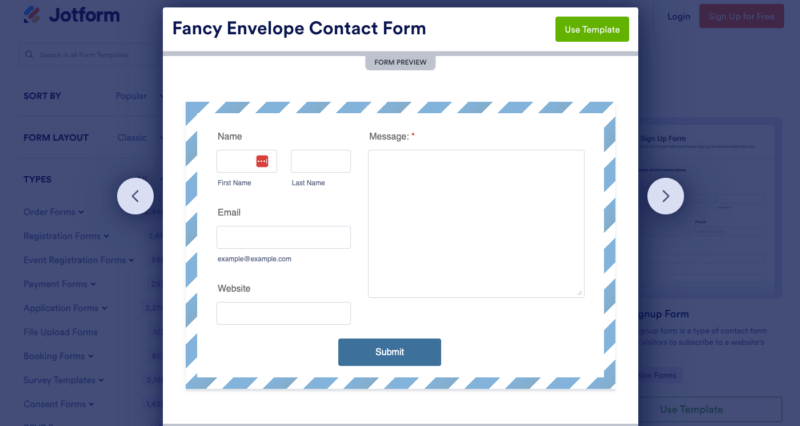
Price: Free plan available; premium plans vary Specifications:
Extensive template library
Drag-and-drop interface
Pros:
Wide range of templates for different industries
User-friendly interface with drag-and-drop feature
Payment solutions integration
Cons:
Feature-rich platform can be overwhelming for new users
Jotform stands out as a versatile champion in the form-building league, offering a treasure trove of templates for online forms that cater to a diverse range of sectors, including healthcare and education. Its user-friendly ethos shines through its drag and drop interface, making form creation a breeze for those without a coding background. Businesses can tap into Jotform’s array of templates, from hotel bookings to feedback forms, all with integrated payment forms options.
However, as with any hero, there’s a kryptonite. For Jotform, it’s the sheer magnitude of features that can send new users into a dizzying spin. But once you get the hang of it, you’ll find yourself crafting beautiful, functional forms in no time.
Rating:
Ease of Use: 4/5
Template Variety: 5/5
Customization: 4/5
Value for Money: 4/5
Google Forms: Best for Tight Budgets and Simplicity
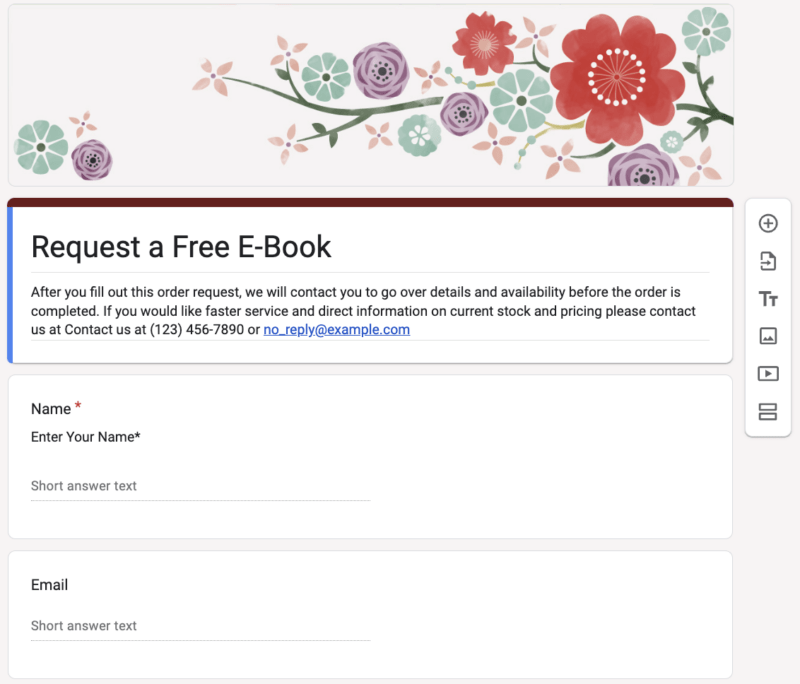
Price: Free Specifications: (Not applicable) Pros:
Completely free to use
Seamless integration with Google Workspace
Straightforward form creation
Cons:
Limited design customization options
For those whose pockets aren’t lined with gold, Google Forms presents itself as a knight in shining armor. It’s the epitome of simplicity, offering a zero-cost solution for crafting basic, yet functional forms. The integration with Google Workspace is like a cherry on top, making data management and collection a synch with companions like Google Sheets and Gmail.
But even knights have their weak spots, and for Google Forms, it’s the modest wardrobe of design customizations. Yet, for the price of nada, it’s a trade-off many are willing to embrace, especially when simplicity and functionality are the main quests.
Rating:
Ease of Use: 5/5
Design Flexibility: 2/5
Integration: 4/5
Value for Money: 5/5
GetLeadForms: Optimal for High-Converting Lead Capture
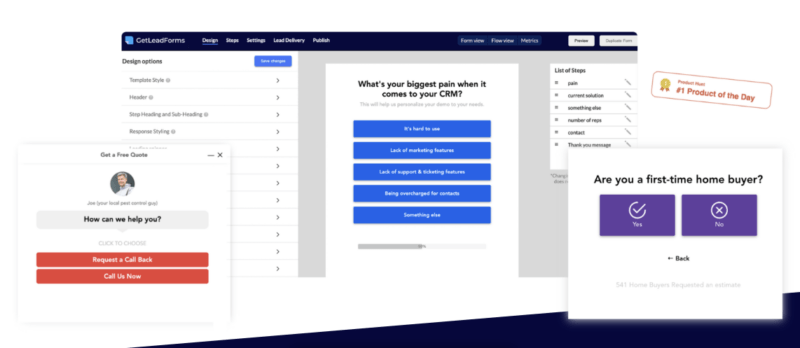
Price: Starting from $37/month
Our platform offers a seamless form creation process, including multi-step form creation and a phone verification feature.
Pros:
Boosts conversion with multi-step forms and quizzes
Industry-specific templates
Advanced features like A/B testing and social proof
Cons:
Can be more expensive than basic form builders
If you’re on the hunt for a lead generation ace that knows the art of conversion, GetLeadForms is your huckleberry. With its code-free platform, you can create surveys, whip up multi-step forms, quizzes, and other surveys designed to enrapture and convert with ease. The industry-specific templates are a boon for sectors craving a tailored approach, like SaaS and local services.
The platform’s knack for capturing leads is bolstered by features like exit intent popups and A/B testing, ensuring you’re not just shooting arrows in the dark. And let’s not overlook the phone verification feature, adding an extra layer of lead validation to your quiver. Engaging prospects step by step, GetLeadForms keeps them hooked and increases the likelihood of a bullseye in form submissions.
Rating:
Ease of Use: 4/5
Conversion Features: 5/5
Template Variety: 4/5
Value for Money: 3/5
Wufoo: Ideal for Data-Driven Decision Making
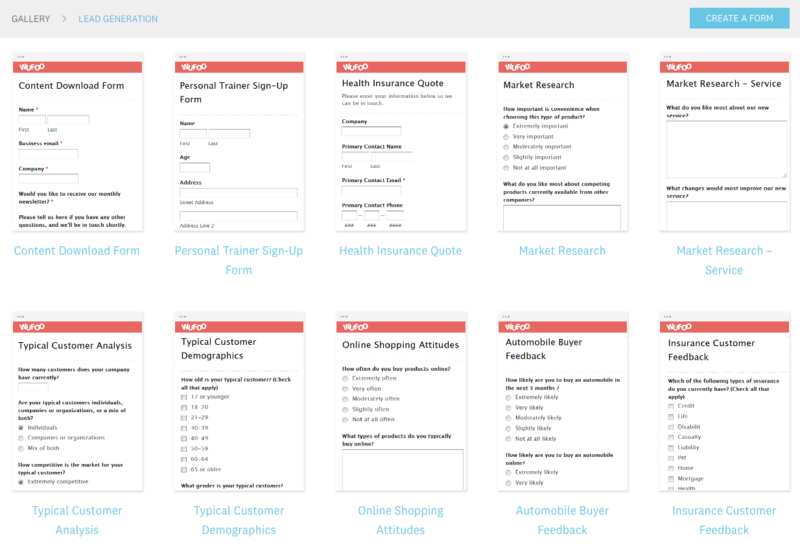
Price: Free plan available; premium plans vary Specifications:
Advanced reporting features
Theme Designer for customization
Pros:
In-depth data analysis tools
User-friendly interface for creating and managing forms to collect data
Password protection for sensitive data
Cons:
The design may feel outdated compared to newer platforms
Wufoo is like the Sherlock Holmes of form builders, with its magnifying glass firmly on data-driven decision making. Its advanced reporting system is a detective’s dream, tracking user interactions and analytics to uncover the story behind your data. The intuitive interface means you won’t need a Watson to help you manage your forms and reports, either.
However, even Holmes has his eccentricities, and Wufoo’s design might feel a bit Victorian in an age of digital modernism. Yet, with its professional themes and customization capabilities, you can still ensure your forms are dressed to impress.
Rating:
Data Analysis Tools: 5/5
Ease of Use: 4/5
Design Flexibility: 3/5
Value for Money: 4/5
OhMyForm: The Open-Source Enthusiast’s Choice
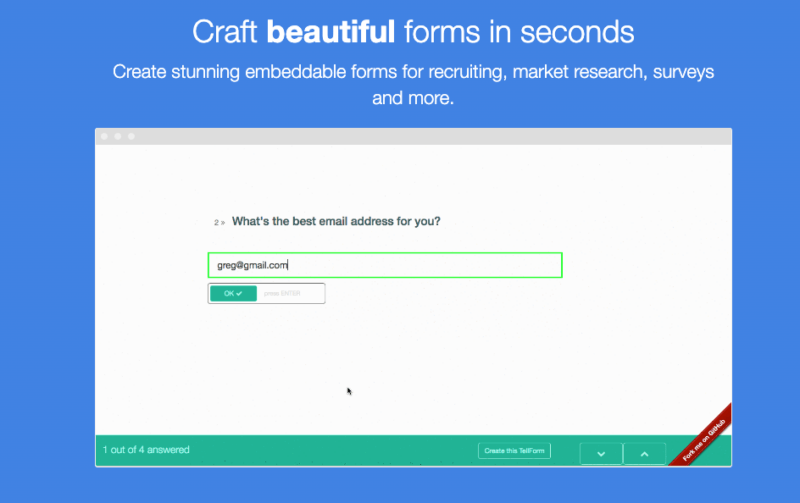
Price: Free Specifications:
Open-source platform
Self-hosting capabilities
Pros:
Full control over the source code
Customization for specific needs
Regularly updated by an active community
Cons:
Requires technical knowledge for setup and customization
For the tinkerers and builders who love to get their hands dirty, OhMyForm offers unlimited forms and:
An open-source sandbox of possibilities
The ability to mold and shape your forms to your heart’s content
Self-hosting capabilities, giving you full control over the source code
The keys to the form kingdom, where you can build towering castles or cozy cottages, depending on your whims.
However, this kingdom does come with its fair share of challenges. The open-source nature of OhMyForm means you’ll need a good grip on technical skills, including a familiarity with TypeScript. But for those who speak the language, it’s a land of endless opportunity, with a community of fellow developers ensuring the code is as sharp as a knight’s sword.
Rating:
Customization: 5/5
Ease of Use: 3/5
Community Support: 4/5
Value for Money: 5/5
TellForm: Best for Developers Seeking Flexibility
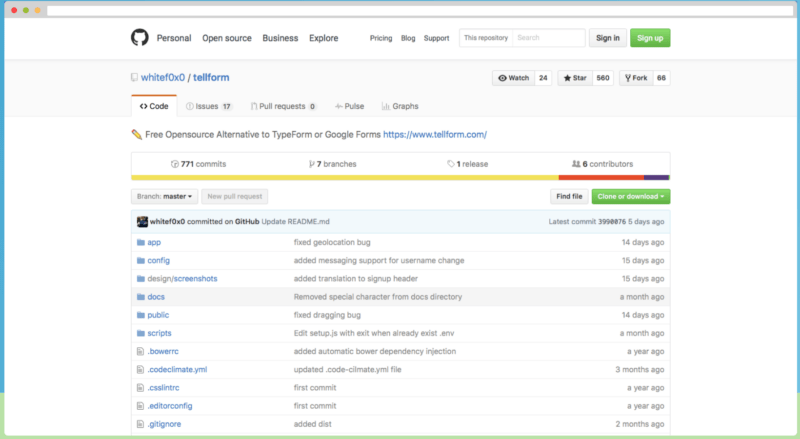
Price: Free
Specifications:
High design flexibility
Customization for developers
Key features
Pros:
Extensive branding and customization options
Appeals to developers’ need for control
Flexible for specific client needs or preferences
Cons:
Less intuitive for non-developers
Very similar to OhMyForm, TellForm is akin to a master blacksmith’s toolkit, offering developers the flexibility to forge forms as they see fit. Its design flexibility is critical for those who view forms not just as a means to an end but as a canvas for creativity and customization. Whether you’re crafting a sword or a ploughshare, TellForm equips you with the tools to ensure it fits your exact specifications.
However, not all knights are blacksmiths, and those without coding expertise may find themselves a bit lost in the forge. For developers with a clear vision and the skills to realize it, TellForm is a powerful ally in the quest to create forms, especially when dealing with complex forms and contact forms. As a typeform alternative, it offers a user-friendly experience for those who may not have coding expertise.
Rating:
Customization: 5/5
Ease of Use: 3/5
Flexibility: 5/5
Value for Money: 4/5
FormTools: The Backend Powerhouse for Form Management
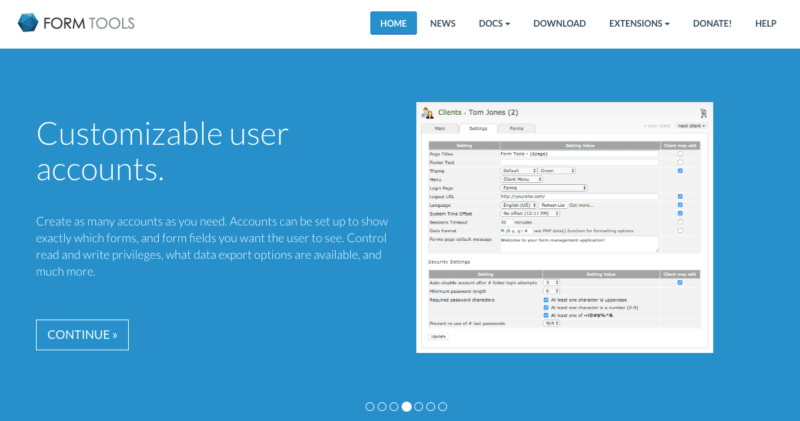
Price: Free version available; premium plans vary Specifications:
Backend form management system
CRM integration capabilities
Pros:
Robust customization options
Can handle sensitive information securely
Extensible through various modules
Cons:
May require more flexible pricing options
FormTools is the Merlin of form builders, wielding powerful magic in the realm of backend management. With its suite of customization options and CRM integrations, it’s like having a spellbook that can conjure up the most intricate data management solutions. The platform’s modules are like mystical charms, each adding a unique touch to your forms, whether you’re safeguarding a kingdom’s worth of sensitive information or simplifying a peasant’s data entry task.
But even Merlin had his limits, and for FormTools, it’s the quest for a pricing model as flexible as its features. Nonetheless, for those seeking a robust backend system that can tackle complex data with the wisdom of a wizard, FormTools is an enchanting choice.
Rating:
Customization: 5/5
Ease of Use: 4/5
Integration: 4/5
Value for Money: 3/5
Customer Feedback: N/A
Choosing the Right Form Builder for Your Lead Generation Needs
The quest for the perfect form builder is not unlike choosing the right steed for a knightly journey. It’s about finding the balance between strength and agility, aesthetics and functionality. When you’re in the throes of lead generation, the ability to add customized questions and employ conditional logic can make your forms as engaging as a bard’s tale. Integration with marketing platforms and CRMs like Mailchimp and HubSpot is like having squires at your side, managing your leads efficiently.
Consider the following when using FormTools, one of the typeform alternatives:
The ease of transforming existing forms into templates
Ensuring that your forms are not only functional but also visually appealing and easily embeddable on your website
Some users have encountered limitations and bugs with FormTools
As you weigh your options, remember that the right online form builder should enhance your user experience and contribute to the effectiveness of your lead generation efforts.
Summary
In conclusion, the realm of online form builders is vast and varied, each with its own strengths and idiosyncrasies. Whether you seek the all-encompassing power of Jotform, the cost-effectiveness of Google Forms, the conversion mastery of GetLeadForms, or the data wizardry of Wufoo, there’s a tool for every quest. For the open-source adventurers, OhMyForm and TellForm await, while FormTools stands as a bastion of backend prowess. May this guide serve you well in selecting the right form builder for your lead generation journey, and may your inbox overflow with qualified leads.
Frequently Asked Questions
Can I create forms that look professional without any design experience?
Yes, you can easily create professional-looking forms using platforms like Jotform and Wufoo, which provide pre-built templates and drag-and-drop builders to simplify the process.
Are there any free options for form builders that still offer robust features?
Yes, you can use Google Forms for free to create basic forms, while OhMyForm and TellForm provide more advanced features at no cost if you have some technical skills. Give them a try!
How can I ensure the data I collect through forms is secure?
To ensure the security of the data you collect through forms, consider using form builders with security features like SSL encryption and options to password-protect your forms. These features are available in platforms such as Wufoo and FormTools.
Is it possible to integrate these form builders with other tools I’m using?
Yes, many form builders offer integration with a variety of tools such as CRM systems, email marketing services, and analytics tools, providing seamless connectivity for your workflow.
What should I consider when choosing a form builder for lead generation?
When choosing a form builder for lead generation, consider factors like customization ease, engaging form options, integration capabilities, and pricing that fits your budget. Focus on these key aspects to make the best choice for your needs.

